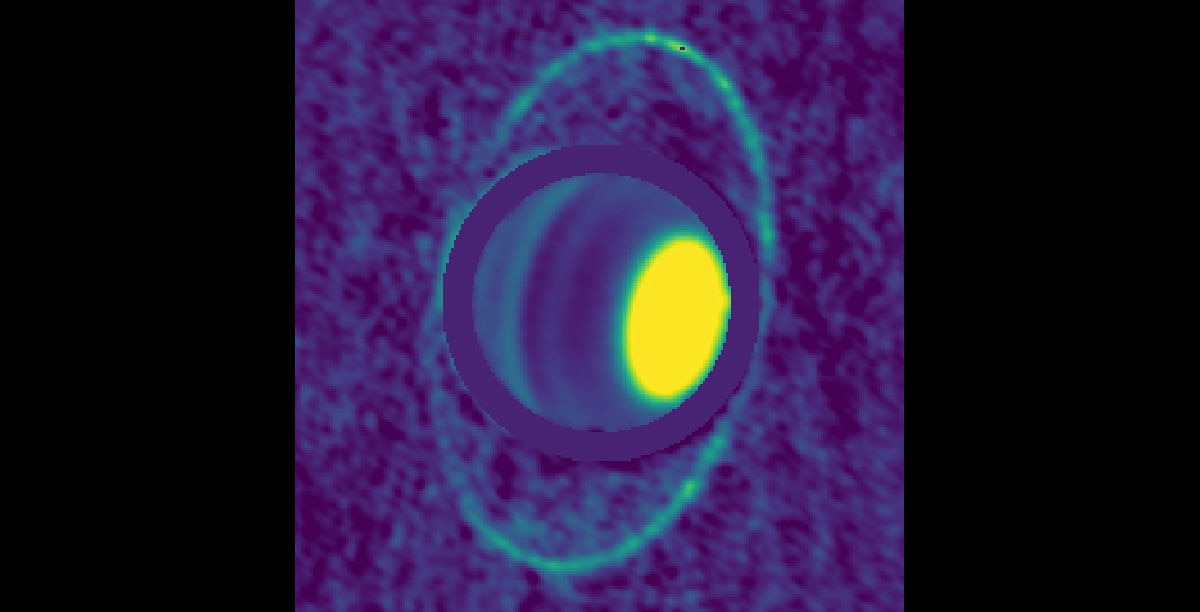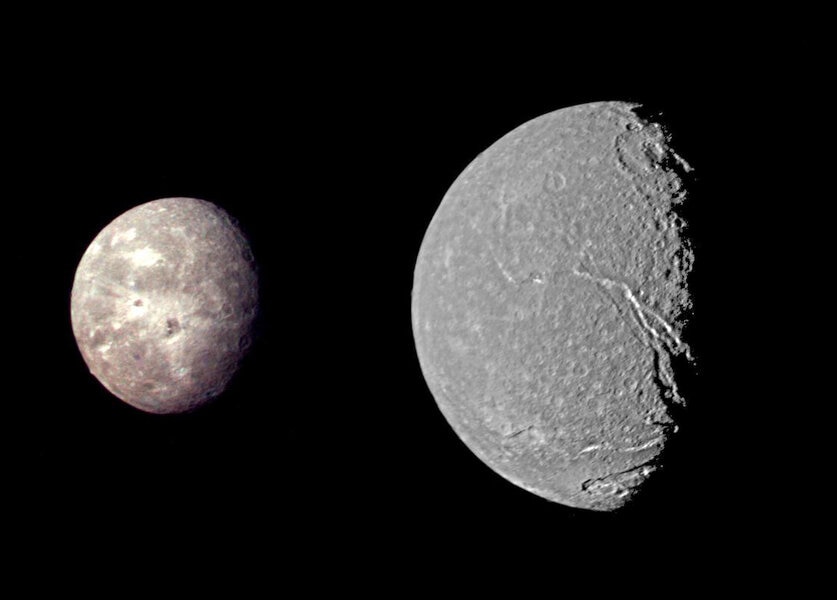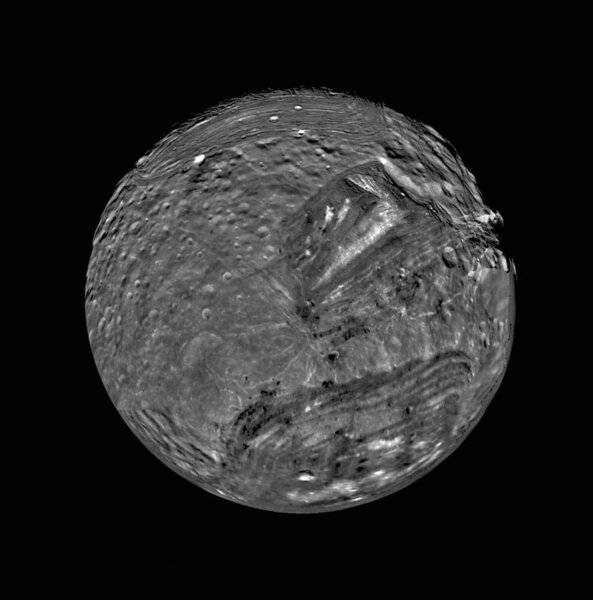Create a free profile to get unlimited access to exclusive videos, sweepstakes, and more!
Uranus got its moons when a big rocky planet whacked it. Maybe.
Planet-on-planet giant impact may explain a lot of weirdness with Uranus.

Uranus is weird*.
For one thing, something knocked it over on its axis. Earth, for example, has its rotation axis — the north/south pole line — tipped over by about 23° from the plane of its orbit, but Uranus is tipped by a whopping 98°. That’s never been conclusively explained.
Its big moons are a little weird, too. There are five of them, and they all orbit the planet in the same direction as Uranus rotates, as well as in the plane of its equator. The innermost one, Miranda, is the least massive; the next two, Ariel and Umbriel, are more massive; and the outermost two, Titania and Oberon, are the most massive. The densities of the moons increase in much the same way from inner to outermost. That’s suspicious, like somehow their overall masses and densities are related to how far they are from the planet.
It’s actually a little odd they exist at all. Jupiter and Saturn were big enough as they formed to draw in a huge amount of gas around them, increasing their size rapidly, and that also may have helped the formation of their moons. Uranus and Neptune are much less massive, and probably didn’t undergo this phase, called runaway gas accretion, so how the moons formed is unclear. The moons are also roughly half rock and half ice, which is hard to explain as well.
It’s been thought for a while that Uranus suffered an enormous impact sometime in the past, which could explain its tilt and maybe some other of the planets’ features as well. Could it also explain the moons?
A new research paper shows that it’s possible [link to paper]. Updating previous research, they simulated giant planet-on-planet impacts using computer models called smoothed-particle hydrodynamics that track what happens to material during and after the impact, assuming different sized impactors made of different kinds of material. In all cases, the impact blasts material away from Uranus into space, where it quickly falls into a flattened disk made of dust from the impactor and vapor from the planet. Once that disk forms, they follow its evolution to see how the moons could form from it.
Importantly, they track what happens to the disk due to its thermal properties — heated material will act differently than stuff that starts cold — and its viscosity, how thick a fluid it is (for example, syrup is more viscous than water).
What they found is interesting: If the impactor was a planet-sized rocky beast with about three times Earth’s mass, hits at an oblique angle, and is moving at the terrifying speed of 65,500 kilometers per hour, they can reproduce a lot of the properties seen in the Uranus system.
They get the planet knocked over, for one, which is expected. But they also found that the collision stirs up the outermost layers of Uranus, which is effective at keeping its internal heat trapped inside the planet. Jupiter, Saturn, and Neptune all emit more heat than they get from the Sun, but Uranus emits about as much heat as it gets, indicating its heat is trapped inside and can’t leak out. So that’s a plus for the sims, too.
But more to the point it also reproduces the moons. The disk that forms after impact is initially hot enough — an impact of that size makes a substantial amount of heat — to be gaseous, but then as it spreads out and cools, rock and then ice condenses from it. One thing I found interesting is that if the impactor is too small then something like 99% of the material just falls back onto Uranus, which is why they needed something three times Earth’s mass to smack the planet. All that extra mass makes the disk thicker and able to stick around long enough to form moons at all.
The gaseous vapor in the disk condenses to ice particles relatively rapidly. The gas and solid materials interact, and that dictates what happens next. In the sims, rock particles tended to stay pretty small, around a micron wide (a human hair is 100 microns wide), whereas ice particles grew much larger. The larger the particle the more it can interact with gas, and this separates the ice and rock a bit, with ice moving closer in to Uranus and rock staying all throughout the disk.
That’s why a given moon’s density gets bigger the farther out it is; rock is denser than ice, and the outermost moons formed from a part of the disk that had less ice. Overall, the simulated moons are very roughly half rock and half ice, as is seen in real life, but that ratio gets higher for rock the farther out a moon was. They also find that the sizes of the moons in their sims got bigger farther out in the disk as well, again reproducing what’s seen in real life.
Pretty nifty. They do say they made some simplifications and assumptions in their models, but that most don’t change the physics much. Also, these simulations are not meant to close the book on anything; they’re just the next step in complexity over earlier attempts, and to show that they can reproduce a lot of what’s seen in the system. There’re a lot more steps to take here, but it seems like scientists are indeed zeroing in on why Uranus is such a mess.
* I won’t even go into how its magnetic field, um, pinched off a bit of gas that it then belched — one of many apt metaphors — into space, or how it smells like rotten eggs, or how it was renamed in 2620 to end all the jokes once and for all.




























